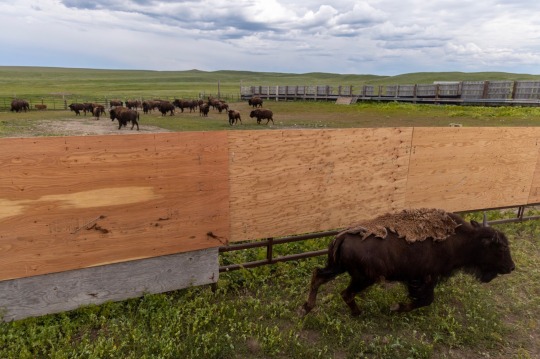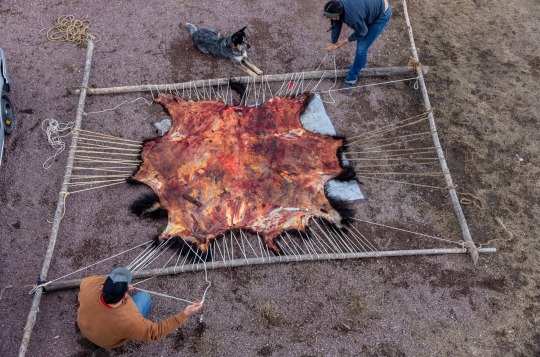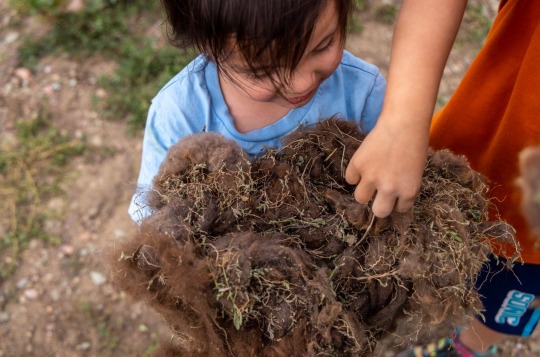#Cristina Mormorunni
Text
At Long Last, The American Buffalo Has Come Home
A conservation effort has returned bison to Blackfeet Nation tribal lands more than a century after the animal was nearly slaughtered to extinction.
— Photographs By Louise Johns | By Lailani Upham | Sunday July 09, 2023

“Nititawahsi” is the Blackfeet name for our land—the land where the iinnii (buffalo) live. Our people are Niitawahsin-nanni: the people of the land where the iinnii live.
As colonizers moved west, millions of buffalo were killed and brought to the edge of extinction. Millions more Native peoples were murdered, displaced, and forced to assimilate. By the end of the 19th century, only 300 buffalo were left in the wild and Native populations dropped to less than 300,000.
Now, after more than 150 years, iinnii have finally returned to their homeland, the Amskapi Pikuni (Blackfeet Nation) tribal lands, to roam free.

Forty-nine buffalo run out of their temporary enclosure towards Chief Mountain on the Blackfeet Reservation. The rest of the herd (about 70 buffalo) will join them at the end of the summer. Chief Mountain is not only prime buffalo habitat, but also a sacred place for Native people in both the U.S. and Canada.
“I can’t hardly describe the feeling that I have. I have this jittery feeling, goosebumps,” says Ervin Carlson, director of the Blackfeet Nation Buffalo Program. “It just feels so good to finally see them here in this place where we want them to be.”
On June 26, 49 iinnii were released into the wild at the base of our sacred Ninaistako (Chief Mountain), a Strong Miistaaki (Mountain) that stands tall like the warbonnets of Blackfeet warriors. This miistaaki towers along the border of the Blackfeet Nation, Glacier National Park in Montana, and Waterton National Park in Canada.
Our people, the Siksikaitsitapi (Blackfoot Confederacy) always believed the land we came from was a gift of the Creator, Ihtsi-pai-tapi-yopa. Our stories tell us that iinnii was created as a gift for our people as our life source. The iinnii were and still are our staff of life.
The iinnii coming back and being free on Blackfoot lands again is the beginning of reconciliation, says Cristina Mormorunni, director of Indigenous Led, the organization that leads cultural restoration and conservation of buffalo on Blackfoot lands. “This is the beginning of the truth being told about what happened, and they’re the best ambassadors,” she says.


Helen Augare, a Blackfeet knowledge keeper and director of the Blackfeet Community College Native Science Field Center, has been an integral voice in the return of buffalo to Chief Mountain for the past 15 years.
Now that the buffalo are free, she says “there’s so much still to reconnect to and learn from them.”
“What does that future look like and what [do] our children and grandchildren need to know to be able to help iinnii live a full and prosperous life with us again?” Augare says. “It entailed everything from healthy people, healthy land, healthy water, and most of all healthy relationships. That in itself requires a lot of healing, growth.”

Buffalo are corralled and sorted (calves from adults, and males from females) at the tribal-owned Buffalo Spirit Hills Ranch on June 25, 2023. The herd, originally from Canada’s Elk Island National Park, have been living on the ranch since 2016. The herd descends from the last remaining wild buffalo before they were nearly extirpated.

Blackfeet tribal member Wyett Wippert takes a photo of his daughter, Ruby, in front of the buffalo in their soft release pen at Chief Mountain. “We put so much of our hearts into getting them here,” he says. “It’s a very good feeling knowing that they are under Chief Mountain. People know what they’re going to be doing for their environment and for us as Blackfeet people.” The buffalo are held here for several hours to settle into their surroundings before being released into the wild.

Racine, Monroe, and director Ervin Carlson of the Blackfeet Buffalo Program, on June 25, 2023, after a long day of preparing buffalo to be released at Chief Mountain. “It’s a lot of work to get these animals to this point… they are wild buffalo,” Racine says. “Nobody can do it by themselves. It’s a real honor to be able to have the Iinnii here and to be doing this.”

Blackfeet tribal members Wyett Wippert and Christen Falcon work together to stretch their bison hide onto their handmade wooden frame, the first step in tanning the hide by hand at their home in East Glacier, Montana. on April 9, 2023.

“Bison are a keystone species, they are ecosystem drivers and engineers. They were here for thousands of years,” says Brandon Kittson, wildlife biologist for Blackfeet Fish and Wildlife. “Now having them back on this landscape is a good thing. It’s going to help revitalize some systems and help drive diversity among the different vegetation and communities found in this area.”

Children collect and examine clumps of buffalo fur from the corral at Buffalo Spirit Hills Ranch on June 25, 2023. The fur is integral to the health of the grassland ecosystem, as certain species of birds use it to line and insulate their nests.
— Photojournalist Louise Johns is a National Geographic Explorer. Her National Geographic Society-funded Project, "Buffalo Renaissance," is about Native American efforts to restore Bison to build cultural resiliency and ecological integrity.
#The National Geographic#American Buffalo#Photojournalist#Louise Johns#Buffalo Renaissance#Amskapi Pikuni (Blackfeet Nation)#Niitawahsin-Nanni#Chief Mountain#Ninaistako (Chief Mountain)#Glacier National Park in Montana#Waterton National Park in Canada#The Siksikaitsitapi (Blackfoot Confederacy)#Cristina Mormorunni#Helen Augare#Montana USA 🇺🇸#Canada 🇨🇦#Brandon Kittson Wildlife Biologist#National Geographic Explorer
4 notes
·
View notes